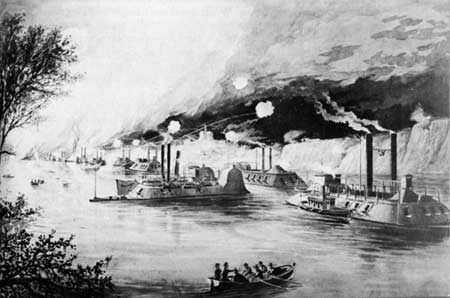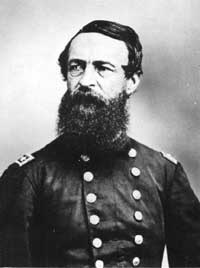|
VICKSBURG National Military Park |
 |

Porter's gunboats running the Vicksburg batteries on the night of
April 16, 1863.
From a wartime sketch.
The Vicksburg
Campaign: Grant Moves Against Vicksburg— and
Succeeds
In the eyes of many in the North, Grant's Army had floundered in the swamps for months with nothing to show for it except a steadily mounting death list from disease. Criticism of the Union commander mounted. "I don't know what to make of Grant, he's such a quiet little fellow," said Lincoln, thinking of the more flamboyant leaders who had led his Eastern armies, "The only way I know he's around is by the way he makes things git." Lincoln had grown increasingly fond of Grant, whose army, while ineffective, had never been inactive. Now he declared to Grant's critics, "I think we'll try him a little longer."
Although Grant had made every effort to navigate the bayous and reach Vicksburg, he was later to record that little hope had been entertained that success would greet these ventures. While waiting for the dry season which would permit land operations, however, he had determined to exhaust every possibility and to retain the fighting edge of his army by keeping it constantly on the move. As April arrived and the roads began to emerge from the slowly receding waters, Grant prepared to execute the movement which he had believed from the first to be the logical approach against Vicksburg—marching down the west bank of the Mississippi through Louisiana, crossing the river south of the city, and laying siege to it from the rear.
 Adm. David Dixon Porter, commanding the Union naval operations on the inland seaters.Courtesy National Archives. |
PORTER RUNS THE VICKSBURG BATTERIES. Grant's Vicksburg campaign officially began on March 29, 1863, when he ordered McClernand's Corps to open a road for the army from Milliken's Bend to the river below the city. Considerable work had been done previously when it was contemplated that a canal from Duckport to the river below Vicksburg might offer passage to the fleet. Falling waters had finally defeated this plan and, during April, McClernand's engineers labored to bridge streams, corduroy roads, and build flatboats to cross areas still covered by flood waters. During that month also, elements of the Army of the Tennessee accomplished the 70-mile march and assembled at a small hamlet appropriately named, Hard Times, in view of Grant's unpleasant bayou experiences. Here they were across the river from the Confederate stronghold of Grand Gulf, 25 miles below Vicksburg.
To ferry the Union Army across the Mississippi, it was necessary for Porter's fleet, in anchorage north of Vicksburg, to run the batteries and rendezvous with Grant below. While naval craft singly and in groups had, on occasion, passed these batteries successfully before, it was still a formidable undertaking for which careful preparation was required. As protection against shellfire, each vessel had its port side, which would face the Vicksburg guns in passage, piled high with bales of cotton, hay, and grain. Coal barges were lashed alongside as an additional defense.
Shortly before midnight, April 16, Confederate pickets in skiffs at the bend of the river above Vicksburg saw the muffled fleet bearing down upon them and quickly gave the alarm. Tar barrels along the bank were ignited and buildings in the small village of De Soto across the river were set afire. The blinding light of a great flare helped illuminate the river and outline the fleet for the Confederate gunners. Tier upon tier of the river batteries thundered down on the Union vessels. In return, these boats delivered their broadsides into the city as they passed so close that the clatter of bricks from falling buildings could be heard on board.
Through this "magnificent, but terrible" spectacle—one of the most fearful pageants of the war—steamed the fleet in single file. "Their heavy shot walked right through us," related Porter. Every one of the 12 boats was hit repeatedly. Many went out of control and revolved slowly with the current. Despite the furious bombardment, only one craft was sunk; within a few days damages were repaired and the fleet joined the army at the village of Hard Times. Because of the difficulty of supplying the army by wagon train over the wretched road from Milliken's Bend, 6 transports and 12 barges loaded with supplies ran the batteries a few nights later with the loss of 1 transport and 6 barges.

|

| History | Links to the Past | National Park Service | Search | Contact |
|
Last Modified: Mon, Dec 2 2002 10:00:00 am PDT |

